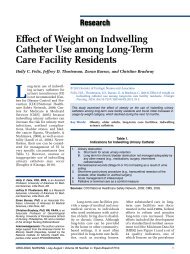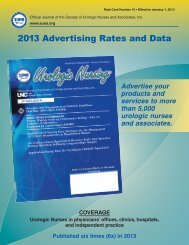SERIESBilling and Coding for <strong>Pessary</strong>ReimbursementTable 3.Commonly Used Billing CodesStandards and guidelines forbilling offer providers the opportunityto receive appropriate compensationand continue their work,and they offer payers the securityof assuring that charges reflectactual services provided. Manyprivate third-party payers followregulations developed by theCenters for Medicare & MedicaidServices (CMS). Information forproviders is available at the CMSWeb site (www.cms.gov), with specificeducational material availablefree of charge through the affiliatedMedicare Learning Network (MLN)(www.cms.gov/MLNGenInfo). ForMedicare purposes, both physiciansand advanced practice registerednurses are fee-for-servicebillers. Providers should regularlyreview changes in standards andguidelines as they become availablethrough the CMS Web site.As part of the billing process,providers designate codes to identify1) either the complexity of thevisit or the time spent with thepatient, if that is unusual related tothe expected complexity of thevisit; 2) specific procedures performedduring the visit; and 3)diagnoses demonstrating at leastprimary and possibly secondaryindications for the care provided(CMS, 2011a). Table 3 lists somecommon codes used for pessaryrelatedbilling. Typically, only oneservice can be billed per office day.In certain circumstances, whenseparate services are provided onthe same day, or a patient receivesservices from separate providerson the same day, a codingModifier may be appropriate toidentify this exception (CMS,2011b). Provider documentationin the medical record justifyingcoding selections is essential toretrospective audit of appropriatebilling. Because the billing pro cessmay not always be straightforward,professional organizationsoften offer Web-based assistance tohelp members, and in some cases,non-members, understand regulationsin a specific field. For exam-Type of Code Description CodeUterovaginal prolapse618.3completeCurrent ProceduralTerminology (CPT)Diagnostic CodeUterovaginal prolapse618.2incompleteCystocele (anterior618.01compartment prolapse)Stress urinary incontinence 625.6Urinary retention 788.20Unspecified non-inflammatory 623.9disorder of the vaginaVulvar atrophy 624.1Vaginitis/vulvitis616.10unspecifiedVaginitis, postmenopausal627.3atrophicVaginal stenosis 623.2Vaginal discharge 623.5Procedure Codes <strong>Pessary</strong> fitting and insertion 057160Vaginal irrigation 57150Supplies Non-rubber pessary (silicone) A4562<strong>Pessary</strong>, rubber, any typeA4561Evaluation andManagement (E&M)Modifier Codesple, the American Congress ofObstetricians and Gynecologists(www.acog.org), the AmericanUrological Association (www.auanet.org), and the AmericanUrogynecologic Society (www.augs.org) offer this type of memberNew patient to practice (novisits in past 3 years), codeselection based oncomplexity OR time.Established patient, codeselection based oncomplexity OR time.Same day: Separate serviceand procedure/sameproviderSame day: Separate service/different provider99203 (Detailed OR30 minutes)99204(Comprehensive OR45 minutes)99212 (ProblemfocusedOR 10minutes)99213 (Expandedproblem-focused OR15 minutes)99214 (Detailed OR25 minutes)Modifier-25Modifier-HOservice. Professional developmentrelated to billing and coding is alsooften included at annual professionalmeetings, such as thosesponsored by the Society ofUrologic Nurses and Associates(www.suna.org).SPECIAL SERIES ON PESSARIESUROLOGIC NURSING / May-June 2012 / Volume 32 Number 3 143
SERIESSPECIAL SERIES ON PESSARIESTable 4.Examples of <strong>Pessary</strong> Types and SizesType Size Variations AvailableRing Available: 0 to 13, in wholenumbers (equal to 1 ¾ to 5Ring with or without centralsupport membrane.inches)Ring with incontinence knobCommon: 2 through 5with or without supportmembrane.DonutInflatableDonutAvailable: 2 to 3 ¾ inches, in ¼inch incrementsCommon: 2 to 3Available: 2, 2.25, 2.50, 2.75inchesGellhorn Sized by the dish diameter:Available: 1 ½ to 3 ¾ inches, in¼ inch increments.Common: 1 ¾ to 3 inchesCube Available: Sizes 0 to 7 (1 to 2¼ inches)Common: 1 to 4Marcia is a 66-year-old woman seen for a routine bi-annualgynecology visit by a new provider who is an enrolledMedicare supplier. The purpose of her original visit meets thecriteria for a preventive visit. During a comprehensive interview,she reports feeling something new coming out of her vagina,with increasing pelvic pressure in the afternoon and evening. Acomprehensive physical examination (PE) confirms incompleteuterovaginal prolapse. Marcia is shown anatomical drawings tohelp her understand what is happening, and her options forcare are reviewed. She decides to try a vaginal support pessary,(see Table 4) and is easily fitted with a Ring pessary. Shefinds it very comfortable during a 20-minute pessary trial performinggeneral activities, such as walking in the office hallway.She verbalizes understanding of the importance of regular followup, typical expectations related to wearing a pessary, andwarning signs that would indicate she should call her provider.Marcia leaves with the pessary in place, written informationabout pessary care, and an appointment to return in two weeksfor a review of her satisfaction with the pessary, examination forpessary-related mechanical injury, and instruction related topessary self-removal and reinsertion.The provider documents the findings of the history andPE, reporting that during the 90-minute visit, 30 minutes werespent completing the preventative history and PE; 25 minutesinvolved face-to-face patient education related to pelvic prolapseand treatment options, and 15 minutes were spent fittingthe pessary. The remainder of the 90 minutes, while Marciatested the pessary by walking in the hall and going to the bathroom,was not face-to-face time with the provider, and that timeis not included in the coding documentation.When preparing the bill for this visit, the provider includescodes for a Preventive Visit for a new patient over the age of 65(Code 099387), with related diagnostic codes, such asGynecologic Examination Routine (V72.31) with CervicalRoutine Pap (V76.2); a modifier for Separate Evaluation andManagement and Procedure, Same Day, Same ProviderSilicone Inflato-Donut or latexInflato-BallLong stem or short stemChoose option with drainageholes. Compressibility will varyby manufacturer.Figure 5.Case Example: <strong>Pessary</strong> Billing and CodingFigure 5 describes a caseexample of billing and commoncodes used during a hypotheticalpatient’s pessary care. However,the information in this article canonly serve as an introduction tothis complex topic. Regulationschange, and the ultimate responsibilityfor conforming to regulationsrests with the provider.ConclusionVaginal support pessaries arean important treatment optionfor women who report symptomsrelated to loss of pelvic support.Careful consideration of pessarypractice options combined withknowledgeable billing practicesshould allow providers in a varietyof settings to offer pessary fittingand follow up as an essential,cost-effective component ofwomen’s pelvic health care.(Modifier-25); a Procedure code for <strong>Pessary</strong> Fitting andInsertion (057160); a Supply code for <strong>Pessary</strong>, Non-Rubber(A4562), and the Current Procedural Terminology (CPT) diagnosticcode for uterovaginal prolapse incomplete (618.2).Marcia calls to ask some questions in the next two weeks.Later, she forgets her appointment and has to be called to berescheduled. During that call, the rationale and importance ofregular follow up is re-addressed. The provider does not submita bill for the 25 minutes spent during these two phone interactionsbecause they are not billable, face-to-face patient education.When Marcia returns, she reports de novo stress incontinence,and the decision is made to change the pessary. Thesesymptoms and the refitting are documented, along with thecontent and time spent for patient education. Because a refittingis required, a billing decision must be made based eitheron procedure (such as a pessary fitting) or time spent (such asusing an appropriate Evaluation and Management code).<strong>Pessary</strong> follow-up visits typically range between 15 to 25 minutesdepending on patient status and complexity (099213 or099214). In this case, the refitting was not complex, and theprovider decided not to reuse the pessary fitting proceduralcode. She discarded the used, unsatisfactory pessary, billed forthe new pessary as a supply, and added the CPT code forstress urinary incontinence (625.6) as a secondary code.If Marcia later returns with a problem, additional secondarydiagnostic coding would be added (vaginitis/vulvitis[616.10], atrophic vaginitis [627.3], vaginal discharge [623.5],postmenopausal bleeding [627.1], urine retention [788.20],mechanical complication of genitourinary device [996.39], andurinary tract infection [599.0]). Specific treatments clinically indicatedby the new diagnosis would be included (irrigation of thevagina [057150], endometrial biopsy [058100], insertion of nonindwellingbladder catheter [051701]), with supply codes ifappropriate. Procedures done at routine visits for additionaldiagnoses would continue to be designated with a Modifier-25.144 UROLOGIC NURSING / May-June 2012 / Volume 32 Number 3
















